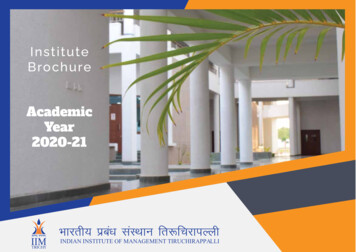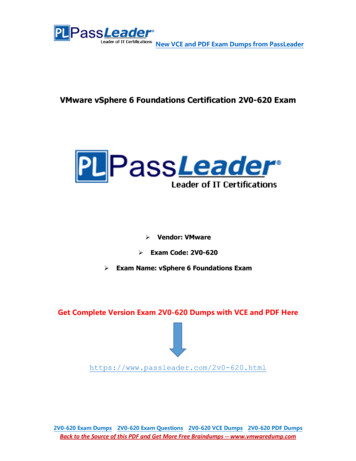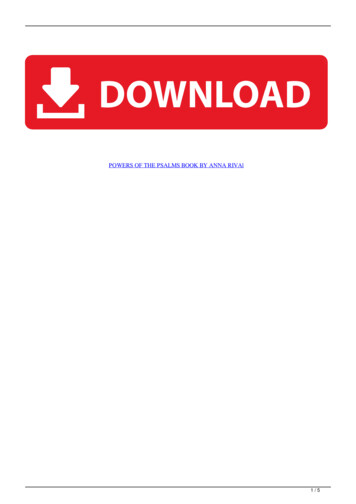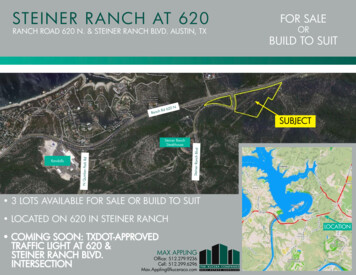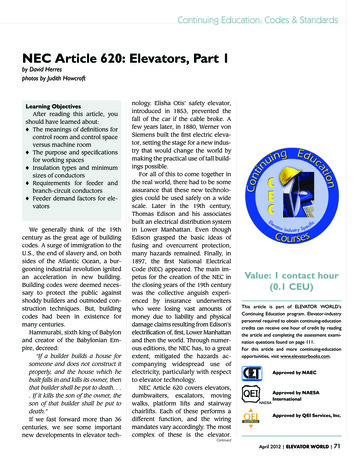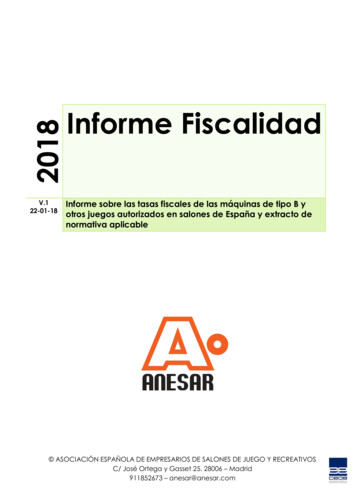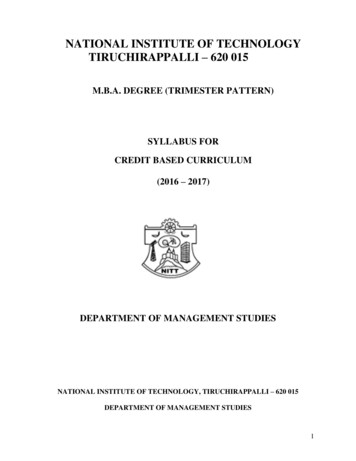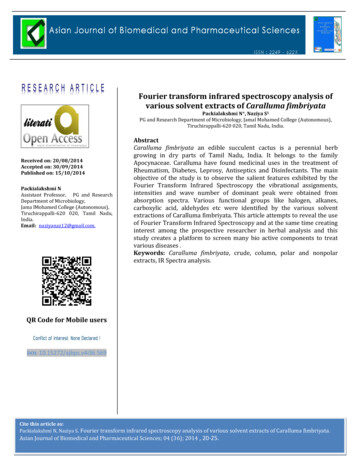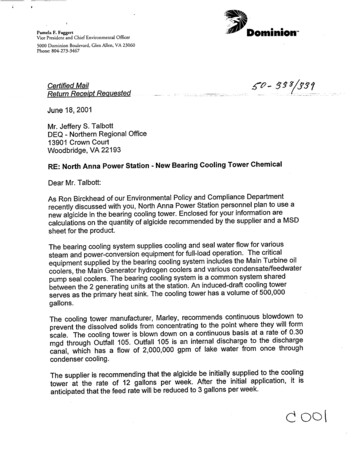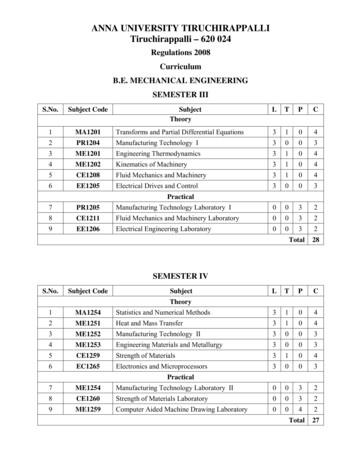
Transcription
ANNA UNIVERSITY TIRUCHIRAPPALLITiruchirappalli – 620 024Regulations 2008CurriculumB.E. MECHANICAL ENGINEERINGSEMESTER IIIS.No.Subject Code1MA12012SubjectTheoryLTPCTransforms and Partial Differential Equations3104PR1204Manufacturing Technology I30033ME1201Engineering Thermodynamics31044ME1202Kinematics of Machinery31045CE1208Fluid Mechanics and Machinery31046EE1205Electrical Drives and Control3003Practical7PR1205Manufacturing Technology Laboratory I00328CE1211Fluid Mechanics and Machinery Laboratory00329EE1206Electrical Engineering Laboratory0032Total28SEMESTER IVS.No.Subject CodeSubjectLTPCTheory1MA1254Statistics and Numerical Methods31042ME1251Heat and Mass Transfer31043ME1252Manufacturing Technology II30034ME1253Engineering Materials and Metallurgy30035CE1259Strength of Materials31046EC1265Electronics and Microprocessors3003Practical7ME1254Manufacturing Technology Laboratory II00328CE1260Strength of Materials Laboratory00329ME1259Computer Aided Machine Drawing Laboratory0042Total27
SEMESTER VS.No.Subject CodeSubjectLTPCTheory1HS1201Environmental Science and Engineering30032ME1301Dynamics of Machinery31043ME1302Design of Machine Elements31044ME1303Gas Dynamics and Jet Propulsion31045ME1304Engineering Metrology and Measurements30036ME1305Applied Hydraulics and Pneumatics3003Practical7ME1306Dynamics Laboratory00328ME1307Metrology and Measurements Laboratory00329ME1308Thermal Engineering Laboratory I0032Total27SEMESTER VIS.No.Subject CodeSubjectLTPCTheory1MG1351Principles of Management30032ME1351Thermal Engineering31043ME1352Design of Transmission Systems32044AT1360Automobile Engineering30035ME1353Power Plant Engineering30036E1****Elective I3003Practical7ME1354Thermal Engineering Laboratory II00328ME1355CAD / CAM Laboratory00329ME1356Design and Fabrication Project0042Total26
SEMESTER VIIS.No.Subject CodeSubjectLTPCTheory1MG1301Total Quality Management30032ME1401Finite Element Analysis31043ME1402Mechatronics31044ME1403Computer Integrated Manufacturing31045E2****Elective II30036E3****Elective III30037ME140400328ME1405PracticalComputer Aided Simulation and AnalysisLaboratoryMechatronics Laboratory00329HS1301Communication and Soft Skills Laboratory0032Total27SEMESTER VIIIS.No.Subject CodeSubjectLTPCTheory1GE1451Engineering Economics and Cost Analysis30032E4****Elective IV30033E5****Elective V30030066Practical4ME1455Project WorkTotal15
ELECTIVES FOR SEMESTER VIS.No.Subject CodeSubjectLTPCTheory1PR1351Unconventional Machining Processes30032MG1452Marketing Management30033ME1001Refrigeration and Air-conditioning30034ME1002Vibration and Noise Control30035ME1003Renewable Sources of Energy30036MA1251Numerical Methods30037PR1353Quality Control and Reliability Engineering3003LTPCELECTIVES FOR SEMESTER VIIS.No.Subject CodeSubjectTheory1GE1452Process Planning and Cost Estimation30032IC1404Robotics30033PR1303Design of Jigs, Fixtures and Press Tools30034ME1004Nuclear Engineering30035ME1005Computational Fluid Dynamics30036ME1006Modern concepts of Engineering Design30037ME1007Thermal Turbo Machines30038ME1008Composite Materials3003LTPCELECTIVES FOR SEMESTER VIIIS.No.Subject CodeSubjectTheory1ME1009Production Planning and Control30032ME1010Advanced Strength of Materials30033ME1011Product Design and Costing30034MG1001Operations Research30035ME1012Maintenance Engineering30036ME1013Entrepreneurship Development30037GE1301Professional Ethics and Human Values3003
ANNA UNIVERSITY TIRUCHIRAPPALLITiruchirappalli – 620 024Regulations 2008SyllabusB.E. MECHANICAL ENGINEERINGSEMESTER IIIMA1201 – TRANSFORMS AND PARTIAL DIFFERENTIAL EQUATIONS(Common to Aeronautical, Automobile, Marine, Mechanical and Production)L T3 1P C0 4UNIT IFOURIER SERIES9Dirichlet’s conditions – General Fourier series – Odd and even functions – Half range sine series –Half range cosine series – Complex form of Fourier Series – Parseval’s identity – Harmonic Analysis.UNIT IIFOURIER TRANSFORMS9Fourier integral theorem (without proof) – Fourier transform pair – Sine andCosine transforms – Properties – Transforms of simple functions – Convolution theorem – Parseval’sidentity.UNIT IIIPARTIAL DIFFERENTIAL EQUATIONS9Formation of partial differential equations – Lagrange’s linear equation – Solutions of standard typesof first order partial differential equations - Linear partial differential equations of second and higherorder with constant coefficients.UNIT IVAPPLICATIONS OF PARTIAL DIFFERENTIAL EQUATIONS9Solutions of one dimensional wave equation – One dimensional equation of heat conduction – Steadystate solution of two-dimensional equation of heat conduction (Insulated edges excluded) – Fourierseries solutions in Cartesian coordinates.UNIT VZ -TRANSFORMS AND DIFFERENCE EQUATIONS9Z-transforms – Elementary properties – Inverse Z-transform – Convolution theorem – Formation ofdifference equations – Solution of difference equations using Z-transformL: 45 T: 15 Total: 60
TEXT BOOKS1.Grewal, B.S., “Higher Engineering Mathematics”, 40th Edition, Khanna publishers, 2007.2.Erwin Kreyszig, “Advanced Engineering Mathematics”, 8th Edition, Wiley India, 2007.REFERENCES1.Bali, N.P. and Manish Goyal, “A Textbook of Engineering Mathematics”, 7th Edition, LaxmiPublications (P) Ltd., 2007.2.Ramana, B.V., “Higher Engineering Mathematics”, Tata Mc-GrawHill Publishing Companylimited, 2007.3.Glyn James, “Advanced Modern Engineering Mathematics”, 3rd Edition, Pearson Education,2007.
PR1204 – MANUFACTURING TECHNOLOGY IL3T0P C0 3UNIT IMETAL CASTING PROCESSES9Sand casting – Sand moulds - Type of patterns – Pattern materials – Pattern allowances – Types ofMoulding sand – Properties – Core making – Methods of Sand testing – Moulding machines – Typesof moulding machines - Melting furnaces – Working principle of Special casting processes – Shell –investment casting – Ceramic mould – Lost Wax process – Pressure die casting – Centrifugal casting –CO2 process – Sand Casting defects.UNIT IIJOINING PROCESSES9Fusion welding processes – Types of Gas welding – Equipments used – Flame characteristics – Fillerand Flux materials - Arc welding equipments - Electrodes – Coating and specifications – Principles ofResistance welding – Spot/butt – Seam – Projection welding – Percusion welding – GS metal arcwelding – Flux cored – Submerged arc welding – Electro slag welding – TIG welding – Principle andapplication of special welding processes – Plasma arc welding – Thermit welding – Electron beamwelding – Friction welding – Diffusion welding – Weld defects – Brazing – Soldering process –Methods and process capabilities – Filler materials and fluxes – Types of Adhesive bonding.UNIT IIIBULK DEFORMATION PROCESSES9Hot working and cold working of metals – Forging processes – Open impression and closed dieforging – Characteristics of the process – Types of Forging Machines – Typical forging operations –Rolling of metals – Types of Rolling mills – Flat strip rolling – Shape rolling operations – Defects inrolled parts – Principle of rod and wire drawing – Tube drawing – Principles of Extrusion – Types ofExtrusion – Hot and Cold extrusion – Equipments used.UNIT IVSHEET METAL PROCESSES9Sheet metal characteristics – Typical shearing operations – Bending – Drawing operations – Stretchforming operations –– Formability of sheet metal – Test methods – Working principle and applicationof special forming processes – Hydro forming – Rubber pad forming – Metal spinning – Introductionto Explosive forming – Magnetic pulse forming – Peen forming – Super plastic forming.UNIT VMANUFACTURING OF PLASTIC COMPONENTS9Types of plastics – Characteristics of the forming and shaping processes – Moulding ofThermoplastics – Working principles and typical applications of – Injection moulding – Plunger andscrew machines – Compression moulding – Transfer moulding – Typical industrial applications –Introduction to Blow moulding – Rotational moulding – Film blowing – Extrusion – Thermoforming –Bonding of Thermoplastics.Total: 45
TEXT BOOKS1.Hajra Choudhury, “Elements of Workshop Technology, Vol. I and II”, Media Promotors PvtLtd., 20012.S.Gowri, P.Hariharan, and A.Suresh Babu, “Manufacturing Technology I”, Pearson Education,2008.REFERENCES1.B.S. Magendran Parashar & R.K. Mittal, “Elements of Manufacturing Processes”, PrenticeHall of India, 2003.2.P.N. Rao, “Manufacturing Technology”, 2nd Edition, Tata McGraw-Hill Publishing Limited,2002.3.P.C. Sharma, “A Text Book of Production Technology”, 4th Edition, S. Chand and Company,2003.
ME1201 – ENGINEERING THERMODYNAMICS(Common to Mechanical and Automobile)L3T1P C0 4UNIT IBASIC CONCEPTS AND FIRST LAW9Concept of continuum – macroscopic approach – Thermodynamic systems – closed –open – isolated –Thermodynamic Property – state – path and process – quasi-static process – work –modes of work –Zeroth law of thermodynamics – concept of temperature and heat – Concept of ideal and real gases –First law of thermodynamics – application to closed and open systems – internal energy – specific heatcapacities – enthalpy – steady flow process with reference to various thermal equipmentsUNIT IISECOND LAW9Second law of thermodynamics – Kelvin’s and Clausius statements of second law – Reversibility andirreversibility – Carnot theorem – Carnot cycle – Reversed carnot cycle – efficiency – COP –Thermodynamic temperature scale – Clausius inequality – concept of entropy – entropy of ideal gas –principle of increase of entropy – availability.UNIT IIIPROPERTIES OF PURE SUBSTANCE AND STEAM POWER CYCLE9Properties of pure substances – Thermodynamic properties of pure substances in solid, liquid andvapour phases – phase rule – P-V – P-T – T-V – T-S – H-S diagrams – PVT surfaces –thermodynamic properties of steam – Calculations of work done – heat transfer in non-flow – flowprocesses – Standard Rankine cycle – Reheat and regenerative cycle.UNIT IVIDEAL AND REAL GASES AND THERMODYNAMIC RELATIONS9Gas mixtures – Properties ideal and real gases – Equations of state – Avagadro’s Law – VanderWaal’s equation of state – compressability factor – compressability chart – Dalton’s law of partialpressure – exact differentials – T-D relations – Maxwell’s relations – Clausius Clapeyron equations –Joule –Thomson coefficientUNIT VPSYCHROMETRY9Psychrometry and psychrometric charts – property calculations of air vapour mixtures – Psychrometricprocess – Sensible heat exchange processes – Latent heat exchange processes – Adiabatic mixing –evaporative coolingL: 45 T: 15 Total: 60(Standard thermodynamic tables, Mollier diagram, Psychrometric chart and Refrigerant propertytables may be used)TEXT BOOKS1.Nag, P.K., “Engineering Thermodynamics”, Tata McGraw-Hill, 1998.2.Cengel, ‘Thermodynamics – An Engineering Approach”, 3rd Edition, Tata McGraw Hill,2003.REFERENCES1.Holman, J.P., “Thermodynamics”, 3rd Edition, McGraw-Hill, 1995.2.Venwylen and Sontag, “Classical Thermodynamics”, Wiley Eastern, 1987.3.Arora, C.P., “Thermodynamics”, Tata McGraw-Hill, 2003.
ME1202 – KINEMATICS OF MACHINERYL3T1P C0 4UNIT IBASICS OF MECHANISMS7Definitions – Link – Kinematic pair – Kinematic chain – Mechanism – Machine – Degree of Freedom– Mobility – Kutzbach criterion (Gruebler’s equation) – Grashoff's law – Kinematic Inversions offour-bar chain and slider crank chain – Mechanical Advantage – Transmission angleDescription of common Mechanisms – Offset slider mechanism as quick return mechanisms –Pantograph – Straight line generators (Peaucellier and Watt mechanisms) – Steering gear forautomobile – Hooke’s joint – Toggle mechanism – Ratchets – Escapements – Indexing MechanismsUNIT IIKINEMATIC ANALYSIS10Analysis of simple mechanisms (Single slider crank mechanism and four bar mechanism) – GraphicalMethods for displacement – Velocity and Acceleration – Shaping machine mechanism – Coincidentpoints – Coriolis acceleration – Analytical method of analysis of slider crank mechanism and four barmechanism – Approximate analytical expression for displacement, velocity and acceleration of pistonof reciprocating engine mechanism.UNIT IIIKINEMATICS OF CAMS8Classifications – Displacement diagrams – Parabolic, Simple harmonic and Cycloidal motions –Graphical construction of displacement diagrams and layout of plate cam profiles – Circular arc andtangent cams – Pressure angle and undercutting.UNIT IVGEARS10Classification of gears – Gear tooth terminology – Fundamental law of toothed gearing and involutegearing – Length of path of contact and contact ratio – Interference and undercutting – Gear trains –Simple – Compound – Epicyclic gear trains – Differentials.UNIT VFRICTION10Dry friction – Friction in screw jack – Pivot and collar friction – Plate clutches – Belt and rope drives– Block brakes – Band brakesL: 45 T: 15 Total: 60TEXT BOOKS1.Ambekar, A.G., “Mechanism and Machine Theory”, Prentice Hall of India, 2007.2.Uicker, J.J., Pennock, G.R. and Shigley, J.E., “Theory of Machines and Mechanisms”(IndianEdition), Oxford University Press, 2003.REFERENCES1.Thomas Bevan, “Theory of Machines”, CBS Publishers and Distributors, 1984.2.Ramamurti, V., Mechanism and Machine Theory”, 2nd Edition, Narosa Publishing House,2005.3.Ghosh, A. and Mallick, A.K., “Theory of Mechanisms and Machines”, Affiliated East-WestPvt. Ltd., 1998.
BIS Codes of Practice/Useful Websites1.IS 2458 : 2001, Vocabulary of Gear Terms – Definitions Related to Geometry2.IS 2467 : 2002 (ISO 701: 1998), International Gear Notation – Symbols for Geometric Data.3.IS 5267 : 2002 Vocabulary of Gear Terms – Definitions Related to Worm Gear Geometry.4.IS 5037 : Part 1 : 2004, Straight Bevel Gears for GeneralEngineering and Heavy Engineering - Part 1: Basic Rack.5.IS 5037 : Part 2 : 2004, Straight Bevel Gears for GeneralEngineering and Heavy Engineering - Part 2: Module and Diametral Pitches.Web site: www.howstuffworks.com
CE1208 – FLUID MECHANICS AND MACHINERY(Common to Mechanical, Automobile, Aeronautical and Production)L3T1P C0 4UNIT IINTRODUCTION9Units & Dimensions – Properties of fluids – Specific gravity – Specific weight – Viscosity –Compressibility – Vapour pressure and gas laws – Capillarity and surface tension – Flowcharacteristics: concepts of system and control volume – Application of control volume to continuityequation – Energy equation – Momentum equation – Moment of momentum equationUNIT IIFLOW THROUGH CIRCULAR CONDUITS9Laminar flow through circular conduits and circular annuli – Boundary layer concepts – Boundarylayer thickness – Hydraulic and energy gradient – Darcy – Weisbach equation – Friction factor andMoody diagram – Commercial pipes – Minor losses – Flow though pipes in series and in parallelUNIT IIIDIMENSIONAL ANALYSIS9Dimension and units: Buckingham’s П theorem – Discussion on dimensionless parameters – Modelsand similitude – Applications of dimensionless parametersUNIT IVROTO DYNAMIC MACHINES9Homologues units – Specific speed – Elementary cascade theory – Theory of turbo machines – Euler’sequation – Hydraulic efficiency – Velocity components at the entry and exit of the rotor – Velocitytriangle for single stage radial flow and axial flow machines – Centrifugal pumps – Turbines –Performance curves for pumps and turbinesUNIT VPOSITIVE DISPLACEMENT MACHINES9Reciprocating pumps – Indicator diagrams – Work saved by air vessels – Rotary pumps –Classification – Working and performance curvesL: 45 T: 15 Total: 60TEXT BOOKS1.Streeter, V.L. and Wylie, E.B., “Fluid Mechanics”, McGraw Hill, 1983.2.Radhakrishnan, E., “Fluid Mechanics”, 2nd Edition, Prentice Hall of India, 2007.REFERENCES1.Ramamritham, S., “Fluid Mechanics, Hydraulics and Fluid Machines”, Dhanpat Rai and Sons,1988.2.Kumar, K.L., “Engineering Fluid Mechanics”, 7th Edition, Eurasia Publishing House (P) Ltd.,1995.3.Bansal, R.K., “Fluid Mechanics and Hydraulics Machines”, Laxmi Publications (P) Ltd., 2007.
EE1205 – ELECTRICAL DRIVES AND CONTROLS(Common to Mechanical, Production and Petrochemical technology)L3T0P C0 3UNIT IINTRODUCTION9Basic Elements – Types of Electric Drives – factors influencing the choice of electrical drives –Heating and cooling curves – Loading conditions and classes of duty – Selection of power rating fordrive motors with regard to thermal overloading and Load variation factorsUNIT IIMOTOR CHARACTERISTICS9Mechanical characteristics – Speed –Torque characteristics of various types of load and drive motors –Braking of Electrical motors – DC motors – Shunt – Series – Compound – Single phase and threephase induction motorsUNIT IIISTARTING METHODS9Types of D.C Motor starters – Typical control circuits for shunt and series motors – Three phasesquirrel cage and slip ring induction motorsUNIT IVCONVENTIONAL AND SOLID STATE SPEED CONTROL OF D.C. DRIVES 9Speed control of DC series and shunt motors – Armature and field control, Ward-Leonard controlsystem - Using controlled rectifiers and DC choppers –applications.UNIT VCONVENTIONAL AND SOLID STATE SPEED CONTROL OF A.C. DRIVES 9Speed control of three phase induction motor – Voltage control, voltage / frequency control, slippower recovery scheme – Using inverters and AC voltage regulators – applications.Total: 45TEXT BOOKS1.Vedam Subramaniam, “Electric Drives (Concepts and Applications)”, Tata McGraw-Hill,2001.2.Nagrath, I.J. and Kothari, D.P., “Electrical Machines”, Tata McGraw-Hill, 1998.REFERENCES1.2.3Pillai, S.K., “A First Course on Electric Drives”, Wiley Eastern Limited, 1998.Singh, M.D. and Khanchandani, K.B., “Power Electronics”, Tata McGraw-Hill, 1998.Partab, H., “Art and Science Utilisation of Electrical Energy”, Dhanpat Rai and Sons, 1994.
PR1205 – MANUFACTURING TECHNOLOGY LABORATORY IL0UNIT ILATHE1.1.Facing, plain turning and step turning1.2.Taper turning using compound rest, Tailstock set over, etc1.3. Single and Multi-start V thread, cutting and knurling1.4.Boring and internal thread cutting.UNIT IIWELDING EXCERCISES2.1.Horizontal, Vertical and Overhead welding.2.2.Gas Cutting, Gas Welding2.3.Brazing - for demonstration purposeUNIT IIISHEET METAL WORK3.1. Fabrication of sheet metal tray3.2. Fabrication of a funnelUNIT IVPREPARATION OF SAND MOULD4.1.Mould with solid, split patterns4.2.Mould with loose-piece pattern4.3.Mould with CoreUNIT VPLASTIC MOULDING5.1Injection Moulding- for demonstration purposeT0P C3 2Total Number of Periods: 45LIST OF EQUIPMENTS151.Centre Lathe with accessories2.Welding2.1Arc welding machine042.2Gas welding machine012.3Brazing machine013.Sheet Metal Work facility3.1Hand Shear 300mm013.2Bench vice053.3Standard tools and calipers for sheet metal work054Sand moulding Facility4.1Moulding Table054.2Moulding boxes, tools and patterns0555.1Plastic MouldingInjection Moulding Machine01
CE1211 – FLUID MECHANICS AND MACHINERY LABORATORY(Common to Mechanical, Production, Aeronautical and Automobile)L0T0P C3 2LIST OF EXPERIMENTS1.Determination of the Coefficient of discharge of given Orifice meter.2.Determination of the Coefficient of discharge of given Venturi meter.3.Calculation of the rate of flow using Rotameter.4.Determination of friction factor for a given set of pipes.5.Conducting experiments and drawing the characteristic curves of Centrifugal pump /Submergible pump6.Conducting experiments and drawing the characteristic curves of reciprocating pump.7.Conducting experiments and drawing the characteristic curves of Gear pump.8.Conducting experiments and drawing the characteristic curves of Pelton wheel.9.Conducting experiments and drawing the characteristics curves of Francis turbine.10.Conducting experiments and drawing the characteristic curves of Kaplan turbine.LIST OF EQUIPMENTS(for a batch of 30 students)1.2.3.4.5.6.7.8.9.10.Orifice meter setupVenturi meter setupRotameter setupPipe Flow analysis setupCentrifugal pump/submergible pump setupReciprocating pump setupGear pump setupPelton wheel setupFrancis turbine setupKaplan turbine setupQuantity: one each.Total Number of Periods: 45
EE1206 – ELECTRICAL ENGINEERING LABORATORY(Common to Mechanical and Production)L0T0P C3 2LIST OF EXPERIMENTS1.2.3.4.5.6.7.8.9.10.11.Load test on DC Shunt & DC Series motorO.C.C & Load characteristics of DC Shunt and DC Series generatorSpeed control of DC shunt motor (Armature, Field control)Load test on single phase transformerO.C & S.C Test on a single phase transformerRegulation of an alternator by EMF & MMF methods.V curves and inverted V curves of synchronous MotorLoad test on three phase squirrel cage Induction motorSpeed control of three phase slip ring Induction MotorLoad test on single phase Induction Motor.Study of DC & AC StartersLIST OF EQUIPMENTS(for batch of 30 students)Equipment1.2.3.4.5.6.7.8.9.10.No.DC Shunt motorDC Series motorDC shunt motor-DC Shunt Generator setDC Shunt motor-DC Series Generator setSingle phase transformerThree phase alternatorThree phase synchronous motorThree phase Squirrel cage Induction motorThree phase Slip ring Induction motorSingle phase Induction motor-2111221111Total Number of Periods: 45
SEMESTER IVMA1254 – STATISTICS AND NUMERICAL METHODS(Common to Automobile, Mechanical and Production)L3T1P C0 4UNIT ITESTING OF HYPOTHESIS9Sampling distributions – Tests for single mean, proportion, difference of means (large and smallsamples) – Tests for single variance and equality of variances – Chi-square test for goodness of fit –Independence of attributes.UNIT IIDESIGN OF EXPERIMENTS92Completely randomized design – Randomized block design – Latin square design - 2 - Factorialdesign.UNIT IIISOLUTION OF EQUATIONS AND EIGENVALUE PROBLEMS9Newton-Raphson method – Gauss elimination method – Pivoting – Gauss-Jordan methods – Iterativemethods of Gauss-Jacobi and Gauss-Seidel – Matrix inversion by Gauss-Jordan method – Eigenvalues of a matrix by Power method.UNIT IVINTERPOLATION, NUMERICAL DIFFERENTIATION AND NUMERICALINTEGRATION9Lagrange’s and Newton’s divided difference interpolation – Newton’s forward and backwarddifference interpolation – Approximation of derivatives using interpolation polynomials – Numericalintegration using Trapezoidal and Simpson’s 1/3 rules.UNIT VNUMERICAL SOLUTION OF ORDINARY DIFFERENTIAL EQUATIONS 9Taylor’s series method – Euler’s method – Modified Euler’s method – Fourth order Runge-Kuttamethod for solving first and second order equations – Milne’s predictor-corrector methods for solvingfirst order equations – Finite difference methods for solving second order equation.L: 45 T: 15 Total: 60TEXT BOOKS1.Johnson, R.A. and Gupta, C.B., “Miller and Freund’s Probability and Statistics for Engineers”,7th Edition, Pearson Education Asia, 2007.2.Grewal, B.S. and Grewal, J.S., “Numerical methods in Engineering and Science”, 6th Edition,Khanna Publishers, 2004.REFERENCES1.Walpole, R.E., Myers, R.H., Myers, S.L. and Ye, K., “Probability and Statistics for Engineersand Scientists”, 8th Edition, Pearson Education Asia, 2007.2.Spiegel, M.R., Schiller, J. and Srinivasan, R.A., “Schaum’s Outlines Probability andStatistics”, Tata McGraw Hill, 2004.3.Chapra, S.C. and Canale, R.P., “Numerical Methods for Engineers”, 5th Edition, TataMcGraw-Hill, 2007
ME1251 – HEAT AND MASS TRANSFERL3T1P C0 4UNIT ICONDUCTION11Basic Concepts – Mechanism of heat transfer – Conduction, convection and radiation – Fourier law ofconduction – General differential equation of heat conduction –– Cartesian and cylindricalcoordinates – One dimensional steady state heat conduction – Conduction through plane wall,cylinders and spherical systems – Composite systems – Conduction with internal heat generation –Extended surfaces – Unsteady heat conduction – Lumped analysis – Use of Heislers chart.UNIT IICONVECTION10Basic Concepts –Heat transfer coefficients – Boundary layer concept – Types of convection – Forcedconvection – Dimensional analysis – External flow – Flow over plates, cylinders and spheres –Internal flow – Laminar and turbulent flow – Combined laminar and turbulent – Flow over bank oftubes – Free convection – Dimensional analysis – Flow over vertical plate, horizontal plate, inclinedplate, cylinders and spheres.UNIT IIIPHASE CHANGE HEAT TRANSFER AND HEAT EXCHANGERS9Nusselts theory of condensation – Pool boiling, flow boiling, correlations in boiling and condensation– Types of heat exchangers – Heat exchanger analysis – LMTD Method and NTU – Effectiveness –Overall heat transfer coefficient – Fouling factors.UNIT IVRADIATION8Basic concepts – Laws of radiation – Stefan Boltzman law – Kirchoffs law –Black body radiation –Grey body radiation – Shape factor algebra – Electrical analogy – Radiation Shields – Introduction togas radiationUNIT VMASS TRANSFER7Basic concepts – Diffusion mass transfer – Fick’s law of diffusion – Steady state molecular diffusion –convective mass transfer – Momentum, heat and mass transfer analogy – Convective mass transfercorrelationsL: 45 T: 15 Total: 60TEXT BOOKS1.Sachdeva, R.C., “Fundamentals of Engineering Heat and Mass Transfer”, New AgeInternational, 1995.2.Incropera, F.P. and DeWitt, D.P., “Fundamentals of Heat and Mass Transfer”, John Wiley andSons, 1998.REFERENCES1.Yadav, R., “Heat and Mass Transfer” Central Publishing House, 1995.2.Ozisik, M.N., “Heat Transfer”, McGraw-Hill Book Co., 1994.3.Kothandaraman, C.P., “Fundamentals of Heat and Mass Transfer” New Age International,1998.
ME1252 – MANUFACTURING TECHNOLOGY IIL3T0P C0 3UNIT ITHEORY OF METAL CUTTING9Introduction – Material removal processes – Types of machine tools – Theory of metal cutting – Chipformation – Orthogonal cutting – Cutting tool materials – Tool wear – Tool life – Surface finish –Cutting fluids.UNIT IICENTRE LATHE AND SPECIAL PURPOSE LATHES9Centre lathe – Constructional features – Cutting tool geometry – Various operations – Taper turningmethods – Thread cutting methods – Special attachments – Machining time and power estimation –Capstan and turret lathes – Automats – Single spindle – Swiss type – Automatic screw type – Multispindle – Turret Indexing mechanism – Bar feed mechanism.UNIT IIIOTHER MACHINE TOOLS9Reciprocating machine tools: shaper, planer and slotter – Milling: types, milling cutters, operations –Hole making – Drilling – Quill mechanism, reaming, boring, tapping – Sawing machine – Hack saw,band saw, circular saw – Broaching machines – Broach construction – Push, pull, surface andcontinuous broaching machinesUNIT IVABRASIVE PROCESSES AND GEAR CUTTING9Abrasive processes – Grinding wheel – Specifications and selection – Types of grinding process –Cylindrical grinding – Surface grinding – Centre less grinding – Honing, lapping, super finishing,polishing and buffing – Abrasive jet machining – Gear cutting – Forming – Generation – Shaping –Hobbing.UNIT VCNC MACHINE TOOLS AND PART PROGRAMMING9Numerical control (NC) machine tools – CNC – Types – constructional details, special features –Design considerations of CNC machines for improving machining accuracy – Structural members –Slide ways – Linear bearings – Ball screws – Spindle drives and feed drives – Part programmingfundamentals – Manual programming – Computer assisted part programming – Turing and machiningcentre.Total: 45TEXT BOOKS1.Hajra Choudry, “Elements of Work Shop Technology Vol. II”, Media Promoters. 2002.2.H.M.T., “Production Technology”, Tata McGraw-Hill, 1998.REFERENCES1.Rao, P.N., “Manufacturing Technology, Metal Cutting and Machine Tools”, Tata McGraw–Hill, 2003.2.Sharma, P.C., “A Text Book of Production Engineering”, 4th Edition, S. Chand and Co. Ltd,1993.3.Groover, M.P. and Zimers Jr., “CAD/CAM”, Prentice Hall of India Ltd., 2004.
ME1253 – ENGINEERING MATERIALS AND METALLURGY(Common to Mechanical, Automobile)L3T0P C0 3UNIT ICONSTITUTION OF ALLOYS AND PHASE DIAGRAMS9Constitution of alloys – Solid solutions, substitutional and interstitial – Phase diagrams, isomorphous,eutectoid, eutectic, peritectic, and peritectroid reactions – Iron – Iron carbide equilibrium diagram –Classification of steel and cast iron, microstructure, properties and applications.UNIT IIHEAT TREATMENT9Definition – Full annealing, stress relief, recrystallisation and spheroidizing – Normalising, hardeningand tempering of steel – Isothermal transformation diagrams – Cooling curves superimposed on I.T.diagram – CCR – Hardenability – Jominy end quench test – Austempering – Martempering – Casehardening – Carburising, nitriding, cyaniding, carbonitriding, flame and induction hardening –Application.UNIT IIIMECHANICAL PROPERTIES AND TESTING9Mechanism of plastic deformation, slip and twinning – Types of fracture – Testing of materials undertension, compression and shear loads – Brinell hardness tests – Vickers hardness tests – Rockwellhardness tests – Impact test – Izod and Charpy, Fatigue and creep tests – Fracture toughness tests.UNIT IVFERROUS AND NON FERROUS METALS9Effect of alloying elements on steel (Mn, Si, Cr, Mo, V, Ti and W) – Properties and applications ofstainless and tool steels – HSLA – Maraging steels – Cast irons – Grey, white malleable, spheroidal –Graphite, alloy cast irons, copper and copper alloys – Brass, bronze and cupronickel – Aluminum andAl-Cu alloy – Precipitation hardening– Bearing alloys.UNITVNON-METALLIC MATERIALS9Polymers – Types of polymer, commodity and engineering polymers – Properties and applications ofPE, PP, PS, PVC, PMMA, PET, PC, PA, ABS, PI, PAI, PPO, PPS, PEEK, PTFE Polymers – Urea andphenol formaldehydes – Engineering ceramics – Introduction to fibre reinforced plastics.Total : 45TEXT BOOKS1.Callister, W.D., “Material Science and Engineering”, John Wiley and Sons 2007.2.Avner, S.H., “Introduction to Physical Metallurgy”, McGraw Hill Book Company, 2007.REFERENCES1.Budinski, K.G. and Budinski, M.K., “Engineering Materials”, Prentice Hall of India, 2002.2.Raghavan,V., “Materials Science and Engineering”, Prentice Hall India, 2007.3.Dieter, G.E., “Mechanical Metallurgy”, Mc Graw Hill Book Company, 1988.
CE1259 – STRENGTH OF MATERIALS(Common to Automobile, Mechanical, Marine and Production)L3T1P C0 4UNIT ISTRESS, STRAIN DEFORMATION OF SOLIDS9Rigid and Deformable bodies – Strength, stiffness and stability – Stresses: Tensile, compressive andshear –
5 ME1005 Computational Fluid Dynamics 3 0 0 3 6 ME1006 Modern concepts of Engineering Design 3 0 0 3 7 ME1007 . Film blowing - Extrusion - Thermoforming - Bonding of Thermoplastics. Total: 45 . TEXT BOOKS 1. Hajra Choudhury, "Elements of Workshop Technology, Vol. I and II", Media Promotors Pvt Ltd., 2001 .
